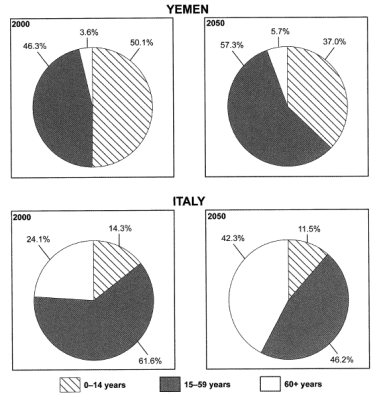GIẢI ĐỀ IELTS WRITING CAMBRIDGE 9- TEST 3- TASK 1
The charts below give information on the ages of the populations of Yemen and Italy in 2000 and projections for 2050.
Summarise the information by selecting and reporting the main features, and make comparisons where relevant.

ANSWER
| The pie charts illustrate the age distributions of the populations in Yemen and Italy in 2000 and projections for 2050. The populations are divided into three age brackets: 0–14 years, 15–59 years, and 60 years or older. Overall, Yemen had a predominantly young population in 2000, whereas Italy had a significantly older demographic. Both countries are projected to experience aging populations by 2050. | Biểu đồ hình tròn minh họa sự phân bổ độ tuổi của dân số ở Yemen và Ý vào năm 2000 và dự đoán cho năm 2050. Dân số được chia thành ba nhóm tuổi: 0–14 tuổi, 15–59 tuổi và 60 tuổi trở lên. Nhìn chung, Yemen có dân số chủ yếu là trẻ vào năm 2000, trong khi Ý có dân số già hơn đáng kể. Cả hai nước đều được dự đoán sẽ có dân số già đi vào năm 2050. |
| In 2000, Yemen had a youthful population with the percentage of the children comprising nearly a half of the total population, followed by the 15–59 age range, which accounted for 50.1%. Finally, the elderly population (60 years or older) made only 3.6%. By 2050, Yemen’s age distribution is expected to shift, with the 15–59 age group increasing to 57.3%, while the percentage of children is anticipated to decrease to 37%. Meanwhile, the elderly segment is forecasted to grow marginally to 5.7%. | Năm 2000, Yemen có dân số trẻ với tỷ lệ trẻ em chiếm gần một nửa tổng dân số, tiếp theo là độ tuổi 15–59, chiếm 50,1%. Cuối cùng, nhóm dân số cao tuổi (60 tuổi trở lên) chỉ chiếm 3,6%. Đến năm 2050, sự phân bổ độ tuổi ở Yemen dự kiến sẽ thay đổi, với nhóm tuổi 15–59 tăng lên 57,3%, trong khi tỷ lệ trẻ em được dự đoán sẽ giảm xuống 37%. Trong khi đó, phân khúc người cao tuổi được dự báo sẽ tăng trưởng nhẹ ở mức 5,7%. |
| In contrast, Italy’s population in 2000 was dominated by the 15–59 age group, which constituted 61.6% of the total. Children aged 0–14 accounted for 14.3%. Finally, the other demographic represented almost a quarter of the population, a markedly higher proportion than that in Yemen. In the next five decades, Italy is forecasted to undergo a substantial demographic change, with senior citizens declining sharply to 42.3% .More noticeably, the rates of individuals aged from15 to 59 years old and children are projected to increase to 46.2%. and 11.5%, respectively. | Ngược lại, dân số Ý năm 2000 chủ yếu là nhóm tuổi 15–59, chiếm 61,6% tổng dân số. . Trẻ em từ 0–14 tuổi chiếm 14,3%. Cuối cùng, nhóm nhân khẩu học còn lại chiếm gần một phần tư dân số, một tỷ lệ cao hơn rõ rệt so với ở Yemen. Trong 5 thập kỷ tới, Ý được dự báo sẽ trải qua một sự thay đổi đáng kể về nhân khẩu học, với tỷ lệ người cao tuổi giảm mạnh xuống 42.3%. Đáng chú ý hơn, tỷ lệ người từ 15 đến 59 tuổi và trẻ em được dự báo sẽ tăng lần lượt lên 46.2% và 11,5%. |
218 words
Written by Ms. Ngọc IELTS (W: 7.5)



